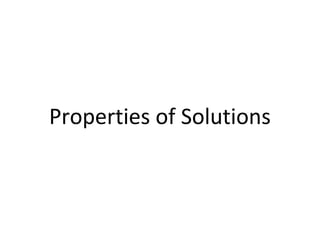
Properties of solutions
- 2. Solution—a homogeneous mixture of two or more substances in a single phase. Does not have to involve liquids. Air is a solution of nitrogen, oxygen, carbon dioxide etc.; solute—component in lesser concentration; dissolvee solvent—component in greater concentration; dissolver solubility—maximum amount of material that will dissolve in a given amount of solvent at a given temperature to produce a stable solution. In other words, the solution is saturated. Saturated solution— a solution containing the maximum amount of solute that will dissolve under a given set of pressure and temperature conditions. Saturated solutions are at dynamic equilibrium with any excess undissolved solute present. Solute particles dissolve and recrystallize at equal rates. Unsaturated solution— a solution containing less than the maximum amount of solute that will dissolve under a given set of conditions. (more solute can dissolve)
- 3. Supersaturated solution—oxymoron—a solution that has been prepared at an elevated temperature and then slowly cooled. It contains more than the usual maximum amount of solution dissolved. A supersaturated solution is very unstable and agitation (stirring, pouring, etc.) or the addition of a “seed crystal’ will cause all excess solute to crystallize out of solution leaving the remaining solvent saturated. (rock candy is made this way as are those liquid hand warmer packets of sodium acetate solution, pictured at left, folks use hunting, at football miscible—When two or more liquids mix (ex. Water and food coloring) immiscible—When two or more liquids DON’T mix.—they usually layer if allowed to set for a while. (ex. Water and oil)
- 4. Solutions • Solutions are homogeneous mixtures of two or more pure substances. • In a solution, the solute is dispersed uniformly throughout the solvent.
- 5. Solutions How does a solid dissolve into a liquid? What ‘drives’ the dissolution process? What are the energetics of dissolution?
- 6. How Does a Solution Form? 1. Solvent molecules attracted to surface ions. 2. Each ion is surrounded by solvent molecules. 3. Enthalpy (∆H) changes with each interaction broken or formed. Ionic solid dissolving in water
- 7. How Does a Solution Form? 1. Solvent molecules attracted to surface ions. 2. Each ion is surrounded by solvent molecules. 3. Enthalpy (∆H) changes with each interaction broken or formed.
- 8. How Does a Solution Form The ions are solvated (surrounded by solvent). If the solvent is water, the ions are hydrated. The intermolecular force here is ion-dipole.
- 9. Energy Changes in Solution To determine the enthalpy change, we divide the process into 3 steps. 1. Separation of solute particles. 2. Separation of solvent particles to make ‘holes’. 3. Formation of new interactions between solute and solvent.
- 11. Enthalpy Is Only Part of the Picture Entropy is a measure of: • Dispersal of energy in the system. • Number of microstates (arrangements) in the system. b. has greater entropy, ∴ is the favored state
- 12. Entropy changes during dissolution Each step also involves a change in entropy. 1. Separation of solute particles. 2. Separation of solvent particles to make ‘holes’. 3. Formation of new interactions between solute and solvent.
- 13. Dissolution vs reaction • Dissolution is a physical change—you can get back the original solute by evaporating the solvent. • If you can’t, the substance didn’t dissolve, it reacted. Ni(s) + HCl(aq) NiCl2(aq) + H2(g) NiCl2(s) dry
- 14. Degree of saturation • Saturated solution Solvent holds as much solute as is possible at that temperature. Undissolved solid remains in flask. Dissolved solute is in dynamic equilibrium with solid solute particles.
- 15. Degree of saturation • Unsaturated Solution Less than the maximum amount of solute for that temperature is dissolved in the solvent. No solid remains in flask.
- 16. Degree of saturation • Supersaturated Solvent holds more solute than is normally possible at that temperature. These solutions are unstable; crystallization can often be stimulated by adding a “seed crystal” or scratching the side of the flask.
- 17. Degree of saturation Unsaturated, Saturated or Supersaturated? ⇒ How much solute can be dissolved in a solution?
- 18. Factors Affecting Solubility • Chemists use the axiom “like dissolves like”: Polar substances tend to dissolve in polar solvents. Nonpolar substances tend to dissolve in nonpolar solvents.
- 19. Factors Affecting Solubility Glucose (which has hydrogen bonding) is very soluble in water. Cyclohexane (which only has dispersion forces) is not water-soluble.
- 20. Factors Affecting Solubility • Vitamin A is soluble in nonpolar compounds (like fats). • Vitamin C is soluble in water.
- 21. Gases in Solution • In general, the solubility of gases in water increases with increasing mass. Why? • Larger molecules have stronger dispersion forces.
- 22. Gases in Solution • The solubility of liquids and solids does not change appreciably with pressure. • But, the solubility of a gas in a liquid is directly proportional to its pressure. Increasing pressure above solution forces more gas to dissolve.
- 23. Temperature Generally, the solubility of solid solutes in liquid solvents increases with increasing temperature.
- 24. Temperature • The opposite is true of gases. Higher temperature drives gases out of solution. Carbonated soft drinks are more “bubbly” if stored in the refrigerator. Warm lakes have less O2 dissolved in them than cool lakes.
